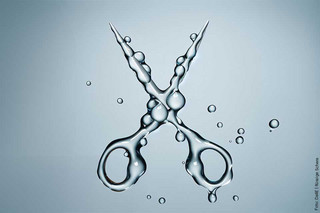Cells, the basic building blocks of plants and organisms, are divided into many small, specialized compartments by membranes. Cellular materials and molecules are constantly exchanged between these organelles. Mechanisms that overcome organelle membranes have so far mainly been attributed to the work of specialized cutting proteins. Professor Dr Roland Knorr's research group at the University of Cologne’s Centre for Biochemistry, together with an international team, has now shown how small cellular liquid droplets, so-called biomolecular condensates, can cross membranes without these specialized cutting proteins. This newly decoded process is essential for the survival of plants. The study "Biomolecular condensates mediate bending and scission of endosome membranes" was published in Nature.
"Condensates can be imagined as a drop of water. The condensate settles on the membrane like a drop of water on a glass surface," explains Professor Knorr. This process is called "wetting". Since a membrane, unlike glass, is a very soft material, wetting by the condensate causes the membrane to deform and enclose the droplet. Teamwork with colleagues from Beijing, London, Freiberg, Tokyo and Hong Kong has now shown that this wetting can also lead to the membrane being cut off. "Contrary to previous assumptions, further specialized cutting proteins are not necessary for this," said Professor Dr Xiaofeng Fang from Tsinghua University in Beijing, who led the study together with Professor Knorr.
To prove this, the team investigated the wetting behaviour of a specific condensate of the protein FREE1, which is essential for the survival of the plant Arabidopsis thaliana. Using a combination of extensive laboratory experiments, a mathematical model and computer simulations, the researchers showed that wetting condensates can exert large capillary forces on membranes. This means that the condensate is not only enclosed by one part of the membrane, but is also cut off on the opposite side. In this way, the condensate passes from one compartment of the cell to another and the membrane, is cut in two.
Condensates as cellular scissors
Condensates in cells are very small and their computer simulations have shown that membrane deformation takes only fractions of a second. As it is difficult to follow this process in living cells, the scientists replicated the cutting process in a test tube. To this end, the FREE1 protein was isolated from cells and purified in the laboratory. Even without a cell, the FREE1 protein forms condensates. These were then brought into contact with artificially produced, cell-like membranes: "No other cellular components such as cutting proteins are present in this experiment. We were thus able to clearly show that FREE1 condensates are sufficient to cut membranes," explained Dr Katharina Sporbeck, co-author and postdoctoral researcher in Knorr's research group.
The current study shows that scissor condensates also function in mammalian cells, that they can replace the absence of specialized cutting proteins and that condensate-membrane wetting is an essential process for cellular stress management. Professor Knorr summarizes: “It is therefore conceivable that scissor condensates play an important role in various medically relevant processes. Autophagy, for example, a recycling process inside the cell, is important in aging processes, in the development of cancer and for immune responses. We are now working on understanding which scissor condensates influence autophagy.”
Media Contact:
Professor Dr Roland Knorr
Centre for Biochemistry
roland.knorruni-koeln.de
Press and Communications Team:
Dr. Anna Euteneuer
+49 221 470 1700
a.euteneuerverw.uni-koeln.de
Publication:
https://doi.org/10.1038/s41586-024-07990-0
Further information:
https://biochemie-med.uni-koeln.de/forschung/arbeitsgruppen/ag-knorr
